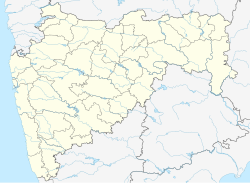Budhwar Peth, Pune
Budhwar Peth
बुधवार
पेठ | |
|---|---|
Suburb | |
| Coordinates: 18°31′01″N 73°51′29″E / 18.517°N 73.858°E | |
| Country | |
| State | Maharashtra |
| District | Pune |
| Languages | |
| • Official | Marathi |
| Time zone | UTC+5:30 (IST) |
| PIN | 411 002 |
| Telephone code | 91(020) |
| Vehicle registration | MH 12 |
Budhwar Peth (Marathi: बुधवार पेठ) is one of many commercial localities in the old city of Pune, India. The area has a high number of electronics shops, is known for its red-light district and is located in the heart of the city. Three out of the five important ganesh mandals (Manache Ganpati) i.e. Jogeshwari Ganpati, Guruji Talim Mandal, Tulshibaug Ganpati are located here, as is Appa Balwant Chowk, known as ABC.
History
For some period, Pune was ruled by the Mughal emperor Aurangzeb of Delhi. When Aurangzeb attacked Pune, he inhabited Budhwar Peth in 1660.[citation needed] In his era, this Peth was known as Mohitabad or Moheyabad. Thorale Madhavrao Peshwa made developments and renamed it as Budhwar Peth when he got the power in their hand. Tulshibag, Belbaugh and Gramdevata Jogeshwari are the historical proofs of Budhawar Peth.
The Bhide Wada, located near Limbraj Maharaj Temple hosted the first school for girls in Maharashtra. The school was started by Savitribai and Jyotiba Phule in January 1848.[1]
Present
Today, Budhwar Peth is a business area particularly for electrical goods market, books and traditional items. Places of interest include; Jogeshwari Temple, N.M.V High School, Laxmi Road, Appa Balwant Chowk and Dagadusheth Halwai Ganapati temple, which is believed to be the richest amongst all Ganesh Temples[citation needed] with the Lord Ganesha icon laden with several lakhs of rupees of gold, and worshipped for obstacle removal.
Red-light district
Budhwar Peth houses India's third largest red-light district.[2] It has been estimated to contain about 700 brothels[3] and 5,000 prostitutes.[2] The area suffers from sex trafficking,[4] child prostitution[5] and police corruption.[6] HIV was formerly a large problem, but an HIV/AIDS programme,[7] including education and condom distribution has resulted in a considerably reduced HIV prevalence.[8] Due to the Covid19 situation workers form this area have been more affected in the terms of financial impact, with many having difficulty earning daily wages.[citation needed]
See also
- Prostitution in India
- Prostitution in Asia
- Prostitution in Kolkata
- Prostitution in Mumbai
- All Bengal Women's Union
- Durbar Mahila Samanwaya Committee
- Sonagachi
- Male prostitution
References
- ^ Salil Urunkar (11 July 2011). "PMC to revive nation's first girl school started by Savitribai Phule". Pune. Retrieved 10 March 2012.
- ^ a b "8 Most Notorious Red Light Areas In India Where Prostitution Is The Only Way Of Living - Stressbuster". DailyHunt. Retrieved 15 December 2018.
- ^ Muralidharan, Shrikanth; Acharya, Arunkumar; Sevekari, Tejaswi; Wadwan, Sanaa; Joglekar, Noopur Rajiv; Margabandhu, Shanthi (2018). "Prevalence of Soft-Tissue Lesions among Women in Sex Work in the Red Light Area of Pune, India: A Cross-Sectional Survey". Journal of International Society of Preventive & Community Dentistry. 8 (3): 218–223. doi:10.4103/jispcd.JISPCD_46_18. ISSN 2231-0762. PMC 5985677. PMID 29911058.
{{cite journal}}: CS1 maint: unflagged free DOI (link) - ^ More, Archana (31 March 2018). "Pune cops book 24 sex traffickers under MCOCA". Pune Mirror. Retrieved 15 December 2018.
- ^ "Pune sex racket: Teens forced into prostitution for Rs 30,000". KANNADIGA WORLD. 24 April 2014. Retrieved 15 December 2018.
- ^ Sahni, Rohini; Shankar, V. Kalyan; Apte, Hemant (2008). Prostitution and Beyond: An Analysis of Sex Workers in India. SAGE Publications India. pp. 229–230. ISBN 9788132100362.
- ^ Higgins, Christina; Norton, Prof Bonny (2009). Language and HIV/AIDS. Multilingual Matters. pp. 125–126. ISBN 9781847693839.
- ^ Mascarenhas, Anuradha (13 December 2011). "Budhwar Peth: HIV prevalence down from 41% to 13% in 3 yrs - Indian Express". archive.indianexpress.com. Retrieved 15 December 2018.
External links
- Pune City Guides - Information about Pune City
- Vishram Baug Wada
- Vishrambag Wada
- Dagdusheth Ganapati


